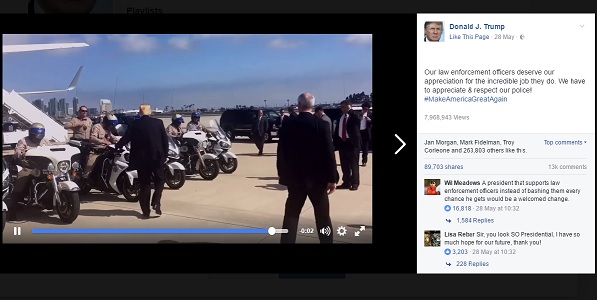How Donald Trump used Facebook Live to help win the election

In a previous post, we looked at the broad role the media played in Donald Trump’s stunning electoral victory last week. Here, I want to look in a little bit more detail at one significant aspect – social media. Or, to put it more bluntly, we’re going to look at how Donald Trump bypassed the mainstream media and used Facebook and Twitter to help win the election.
Data from EzyInsights, an organisation that normally helps news publishers understand how stories play across social media, shows that in the run up to the election earlier this month Trump was often gaining three times more Facebook engagement – likes, reactions, shares, comments – as Clinton.
“With such a significant amount of people getting their news from Facebook, it would be folly to underestimate the importance of winning the battle on Facebook,” said EzyInsights on its blog.
“Here is one area where without a doubt, Donald Trump’s campaign has utterly trounced Hillary Clinton’s.”
Of the two candidates, Trump has the significantly larger Facebook following – 14m page likes compared to Clinton’s 9m – but this doesn’t always translate into appeal. What’s more telling is that at his peak, Trump was gaining around 12m weekly engagements from Facebook users.
Users on Facebook weren’t just ‘liking’ Trump’s links, they were also engaging with a series of native and live video posts published by his campaign.
It’s hard to overstate quite what a powerful campaigning tool live video can be. It represents direct, unmediated contact with followers and floating voters. Equally importantly, live video is also easy for Facebook users to access – and just as easy for them to engage with.
By the end of October, Trump was pushing a total of around 2.5m live video engagements on Facebook, while Clinton was barely achieving 400,000. Not only was engagement better for Trump, he also just posted a lot more live videos. In October, Trump posted 33 compared to Clinton’s 11.
Clearly, Trump did a lot better on social media than Clinton; but why did he have such an advantage? The answer might just be that he gets it; he’s a genuine social media player. Those controversial tweets aren’t the work of junior staff, they’re mainly the candidate. Not only does he tweet three times more often than Clinton, around half are written by Trump himself.
“Hillary Clinton was not a digital candidate,” Andy Serwer, Yahoo Finance’s editor in chief, told thepoliticalinsider.com.
“She does not get the digital economy – and this is a huge and important facet of it [her electoral loss]. One thing about Donald Trump is that he’s a practitioner, he uses Twitter.
“Hillary Clinton might say ‘oh, this social media is important, let me hire someone’. If that’s happening, you’re removed, you don’t really get it. When Trump went to Mexico, we waited around, and we waited for a response from Hillary, and it was something like a day later; that’s not real leadership.
“This stuff clearly matters and Barack Obama, the president for the last eight years, got it a lot more than Hillary Rodham Clinton did.”
But more than one candidate ‘getting it’, the data on social media engagement reveals a more complex picture. It isn’t just as simple Trump being a social media enthusiast and Hillary not understanding digital technology. Strategy is just as vital.
Trump wasn’t just posting more live and native videos than the Clinton campaign, but posting erratically – not just different times, different volumes per day. While Clinton was consistent, Trump kept his audience engaged by not fitting a predictable pattern.
“Some days it was six videos,” Yahoo Finance’s Dan Roberts told thepoliticalinsider.com. “Some live from Trump Tower, some with people discussing the debates, then some days nothing.
“It required fans to pay attention and be ready, and they loved that… it showed they [Trump campaign] had the ability to jump on the news cycle, they were just faster, and now you look back on it you see that it had a major role.”
Live video is growing more than anything else on Facebook and the Trump campaign saw that and took advantage. But how did they know Facebook and live video was such a powerful tool? How did they get so good at social media?
It might be superficially attractive to relate this social media savviness to the appointment of Stephen Bannon, executive chairman of right-wing news site Breitbart News, as Trump’s new chief strategist. But in the aftermath of any seismic event, the temptation to post-rationalise is huge: Trump’s chaotic approach to social media may have turned off just as many voters as it appealed to (after all, he lost the popular vote). And, since it is unprecedented, it is questionable whether another candidate following the same tactics would have the same result.
What is certainly true is that the people that were prepared to hear his message were not listening to the output of “corporate media” – whether across print, digital, broadcast or social channels. And that in Trump’s social media strategy, they found plenty of content to reinforce their world views – and enough rallying cries to make them turn out to vote.